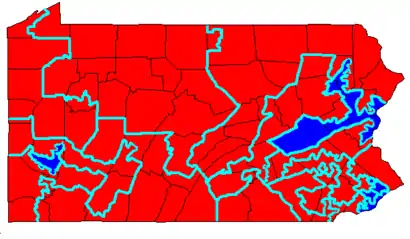
After the 2000 census, the Commonwealth of Pennsylvania was divided into 19 congressional districts, decreasing from 21 due to reapportionment.
After the 2010 census, the number of districts decreased again to 18. In the 2022 midterms, per the 2020 United States census, Pennsylvania lost one congressional seat, bringing the delegation's number to 17 districts.[1]
Current districts and representatives
The congressional delegation from Pennsylvania consists of 17 members. In the current delegation, 9 representatives are Democrats and 8 are Republicans. The list below identifies the members of the United States House delegation from Pennsylvania, their service start dates, and current court-ordered district boundaries.
| Current U.S. representatives from Pennsylvania | |||||
|---|---|---|---|---|---|
| District | Member (Residence)[2] |
Party | Incumbent since | CPVI (2022)[3] |
District map |
| 1st |  Brian Fitzpatrick (Levittown) |
Republican | January 3, 2017 | EVEN | .svg.png.webp) |
| 2nd |  Brendan Boyle (Philadelphia) |
Democratic | January 3, 2015 | D+20 | .svg.png.webp) |
| 3rd |  Dwight Evans (Philadelphia) |
Democratic | November 14, 2016 | D+39 | .svg.png.webp) |
| 4th |  Madeleine Dean (Jenkintown) |
Democratic | January 3, 2019 | D+7 | .svg.png.webp) |
| 5th |  Mary Gay Scanlon (Swarthmore) |
Democratic | November 13, 2018 | D+14 | .svg.png.webp) |
| 6th |  Chrissy Houlahan (Devon) |
Democratic | January 3, 2019 | D+5 | .svg.png.webp) |
| 7th |  Susan Wild (Allentown) |
Democratic | November 27, 2018 | R+2 | .svg.png.webp) |
| 8th |  Matt Cartwright (Moosic) |
Democratic | January 3, 2013 | R+4 | .svg.png.webp) |
| 9th |  Dan Meuser (Dallas) |
Republican | January 3, 2019 | R+21 | .svg.png.webp) |
| 10th |  Scott Perry (Dillsburg) |
Republican | January 3, 2013 | R+5 | .svg.png.webp) |
| 11th |  Lloyd Smucker (Lancaster) |
Republican | January 3, 2017 | R+13 | .svg.png.webp) |
| 12th |  Summer Lee (Swissvale) |
Democratic | January 3, 2023 | D+8 | .svg.png.webp) |
| 13th |  John Joyce (Hollidaysburg) |
Republican | January 3, 2019 | R+25 | .svg.png.webp) |
| 14th |  Guy Reschenthaler (Peters Township) |
Republican | January 3, 2019 | R+18 | .svg.png.webp) |
| 15th |  Glenn Thompson (Howard) |
Republican | January 3, 2009 | R+21 | .svg.png.webp) |
| 16th |  Mike Kelly (Butler) |
Republican | January 3, 2011 | R+13 | .svg.png.webp) |
| 17th |  Chris Deluzio (Aspinwall) |
Democratic | January 3, 2023 | EVEN | .svg.png.webp) |
2012 redistricting and gerrymandering challenge

Red – Republicans (13)
Blue – Democrats (5)
Following the 2010 census, redistricting in Pennsylvania was controlled by elected officials from the Republican party. In 2012, Pennsylvania realigned a number of districts. A number of sitting congressional representatives had their districts modified or merged as part of the redistricting. The merger of districts 4 and 12 forced a primary runoff between the two sitting congressional representatives.[4]
The 2012 redistricting process resulted in a map that disproportionately favored Republican candidates. In the 2012 congressional elections, Democratic candidates won 50.5% of the total votes cast.[5] However, only five of the state's 18 federal Representatives (27.78%) were Democrats.[6]
On June 14, 2017, the League of Women Voters of Pennsylvania filed a lawsuit, alleging that the district boundaries constituted an unconstitutional partisan gerrymander.[7] The case was eventually appealed to the Pennsylvania Supreme Court. On January 22, 2018, the Pennsylvania Supreme Court ruled that the congressional districts were unlawfully gerrymandered in violation of the Pennsylvania Constitution.[8] The court ordered the General Assembly and the governor to adopt a remedied map, to be used for the 2018 congressional elections.[8] Pennsylvania Republicans requested a stay from the United States Supreme Court, to delay the drawing of new district boundaries; however, that request was denied on February 5, 2018.[9] The governor and General Assembly failed to reach an agreement regarding the district boundaries, thus the Pennsylvania Supreme Court drew its own remedial map.[10]
On February 19, 2018, the Pennsylvania Supreme Court released a new congressional map, to take effect for the May 15, 2018, primaries.[11] The Court voted to implement the new map by a 4–3 vote.[12] The map was designed with the assistance of Stanford University law professor Nathaniel Persily.[13] The districts in the Court's map were significantly more compact, and its map split fewer municipalities and counties than the prior Republican-drawn map.[14] While the GOP-drawn map had favored Republican candidates, the court-drawn map is expected not to favor one party over the other.[15]
Republican lawmakers from Pennsylvania requested that the Supreme Court block the implementation of the court-drawn map; however, on March 19, 2018, the United States Supreme Court denied their request.[16] A Pennsylvania federal district court dismissed a parallel suit on the same day.[17] Prior to the 2018 House elections, the Republicans had held 12 seats to 6 for the Democrats, and prior to the March 2018 special election in the 18th district, the delegation had consisted of 13 Republicans and 5 Democrats. The 2018 election resulted in 9 Democrats and 9 Republicans in the delegation.
Historical district boundaries
 Districts 2003–2013
Districts 2003–2013 Districts 2013–2019
Districts 2013–2019 Districts 2019–2023
Districts 2019–2023
See also
References
- ↑ Merica, Dan; Stark, Liz (April 26, 2021). "Census Bureau announces 331 million people in US, Texas will add two congressional seats". CNN. Retrieved April 26, 2021.
- ↑ "Office of the Clerk, U.S. House of Representatives". clerk.house.gov. Retrieved January 10, 2022.
- ↑ "2022 Cook PVI: District Map and List". The Cook Political Report. July 12, 2022. Retrieved January 7, 2023.
- ↑ Gibson, Keegan. "Pa's New Congressional Maps". www.politicspa.com.
- ↑ Wang, Sam (December 5, 2015). "Opinion – Let Math Save Our Democracy" – via www.nytimes.com.
- ↑ "2012 Pennsylvania House Election Results". Politico. Politico LLC. Retrieved October 9, 2014.
- ↑ Marc Levy. "Pennsylvania's US House district borders challenged in court". The Morning Call. Retrieved November 19, 2017.
- 1 2 The Associated Press. "Pa. Supreme Court rules state's congressional districts are unconstitutional". Retrieved January 22, 2018.
- ↑ Mark Scolforo and Mark Sherman. "US Supreme Court Won't Block Pennsylvania Redistricting". Retrieved February 5, 2018.
- ↑ John Finnerty. "Supreme Court will get to pick new map for state's congressional districts". Retrieved February 26, 2018.
- ↑ Lozano, Alicia Victoria (February 19, 2018). "Pennsylvania Court Issues New Congressional Map". NBC 10: NBC Philadelphia. 2018 NBCUniversal Media, LLC. Retrieved February 19, 2018.
- ↑ Lai, Jonathan; Navratil, Liz (February 19, 2018). "Pa. gerrymandering case: State Supreme Court releases new congressional map for 2018 elections". Philadelphia Inquirer. 2018 Philadelphia Media Network (Digital), LLC. Retrieved February 20, 2018.
- ↑ Previti, Emily; Meyer, Katie (February 19, 2018). "In Pennsylvania, New Court-Drawn Voting Map Could Shift Advantage To Democrats". National Public Radio. Retrieved May 4, 2018.
- ↑ Ingraham, Christopher (February 20, 2018). "Pennsylvania Supreme Court draws 'much more competitive' district map to overturn Republican gerrymander". The Washington Post. Retrieved May 4, 2018.
- ↑ Cohn, Nate; Bloch, Matthew; Quealy, Kevin. "The New Pennsylvania Congressional Map, District by District". The New York Times.
- ↑ Lai, Jonathan; Navratil, Liz (March 19, 2018). "Supreme Court upholds new Pa. congressional district map, rejecting Republican challenge – Philly". Philly.com.
- ↑ Joseph Ax (March 19, 2018). "Supreme Court upholds Pennsylvania congressional map in win for Democrats". Reuters.
External links
- Congressional redistricting in Pennsylvania
- Rose Institute of State and Local Government, "Pennsylvania: 2010 Redistricting Changes", Redistricting by State, Claremont, CA: Claremont McKenna College